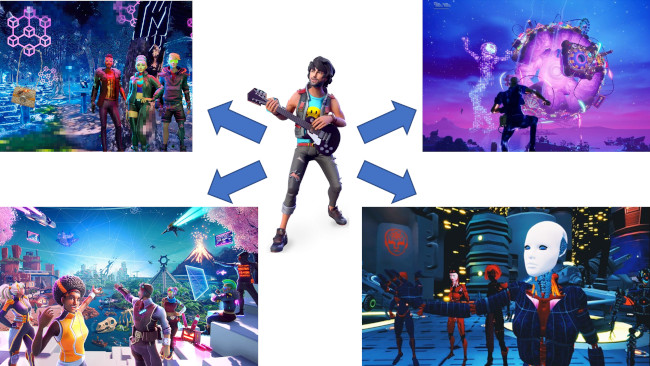And why it has no utility in video games
An Industry That Incentivizes Hype
Blockchain has long been hyped as good for games. Facebook even changed its name to Meta, saying that the Metaverse was a trillion-dollar opportunity. Even though the Metaverse could be used for shopping and other things, essentially the Metaverse was about experiences, which means games.
Meanwhile, many of us who have built virtual worlds for years wondered what the big deal was. I founded Turbine, one of the “big three” first MMO game makers, in 1994. That was an Internet company before the DotCom boom, before PayPal, eBay, Facebook, Google, Amazon, and much else. Turbine went on to make Asheron’s Call, Dungeons & Dragons Online, and Lord of the Rings Online, “Massively Multiplayer Online Games”, or MMOs, whose worlds were “persistent”. That just meant that when you shut off your computer, the game world didn’t reboot. It was an eternal, ever-changing world that each player shared.
In other words, the Metaverse, a word coined by Neal Stephenson in his 1992 book Snow Crash, and we were certainly aware of at the time, and nearly 30 years before Facebook embraced the term in 2021. That’s when I decided to finally look into blockchain. It seemed to be an upcoming technology that I had to learn about, especially if investors were going to ask me about it.
I began this research pretty skeptical, because crypto assets such as NFTs and cryptocurrency have no inherent value. They are only as valuable as people say they are. It smelled a lot like a pyramid scheme to me, and it colored how I saw people talking about blockchain. How much of the talk around blockchain had substance, and how much was a desperate attempt to keep valuations high? Hype almost seemed mandatory. Once you bought into crypto, you had to suck in more people or risk losing your investment.
Sometimes this hype would go to outright deceit, for example wash trading which was found to be more than half of all NFT trades on Ethereum in 2022. Wash trading is when a small group of traders buy each other’s stuff, to fraudulently pump up the volume of trades and make the market seem hot. Meanwhile, nobody is spending or making any money. I’ll buy $1 million of your stuff if you buy $1 million of mine. It’s like when someone’s book hits the New York Times Bestseller List and it turns out it’s only because the author personally bought 50,000 copies. It’s a false signal of value.
Most industries have cheerleaders, of course, but most industries ultimately have at least some basis in hard numbers. Take for example virtual reality, which Meta also embraced and hyped. I’ve never been a fan of the Ready Player One idea that people should wear VR headsets for hours every day, but clearly there is substance there. VR headsets have real utility.
I was also tired of the religious fervor of blockchain people. Because of this built-in incentive where crypto believers have to proselytize to survive, we’ve all had our ears chewed off on this topic. I’ve met plenty of people who took pity on me for missing the trend of Web3 games. Every traditional, non-crypto business (called Web2) would not survive.
Wow! Every business? These advocates seemed divided into two camps: the predators who knew they were pushing some marginal ideas, and the prey who didn’t know, the true believers. Just culturally, I was not eager to join such a community.
How Blockchain is Supposed to Be Used
The central idea of adding blockchain to games is to decentralize game content. Every game has creatures, items, landscapes, and other forms of content that you engage with. If the game is a racetrack, the twists and look of the racetrack are content, the cars are content, the in-game player avatars are content, and so are all the rewards: trophies, better car wheels, and more.
Instead of a “centralized” server, where the racing car game administrates all the game world content, those items can be managed outside of the racing car game. Therefore, supposedly:
- Players could continue to “own” and cherish everything they won in the game even if the game shut down.
- You could make a single player avatar and take it from game to game, along with all your favorite accessories. Why should you have to abandon all the stuff you earned from Game 1 just because you want to play Game 2?
- This would facilitate trading. Instead of being forced to trade items inside a centralized system, players could create their own marketplaces and trade items anywhere, anyhow.
- The value of such traded items would not be constrained by a centralized server. These items would “float” just like assets on a public stock market, which could lead to collectibles crazes as with Pokemon, Magic the Gathering, Beanie Babies, or Cabbage Patch Kids. In such a craze, the value of such items could soar through the roof, with the original game company taking part of each trade or transaction.
Problem 1. Nobody Wants This

The main problem with this use case of blockchain in games is that nobody wants this. This was originally such a controversial opinion that I actually deleted it from the video of my 2021 Metaverse lecture at GIC (Game Industry Conference) in Poland.
But it’s true. Let’s say that I have a player avatar of a hippie guy playing a guitar. Thanks to blockchain, I can now use this avatar in a spy game.
What? What’s hippie guitar guy doing in the spy game?
The player doesn’t want this. If I’m in a spy game, I want to play a spy. If I’m in a robot game, I want to play a robot. The whole reason why the world has more than one video game is because video games have competitive differences from each other, which usually have something to do with the interactivity.
The video game makers also don’t want this. I don’t want my spy game cluttered up with guitar guys that spoil the mood. Or what happens when robot guy gets into my spy game and now the robot guy is too powerful and can’t get shot by any spy?
To be fair, when Mark Zuckerberg talks about the Metaverse he usually says “experiences”, not games. I guess we’re all supposed to be at a dance party or shopping using a single avatar. But basically, it’s games. Even a rather lame ‘dance party’ nightclub simulation is a type of game. And do we always want to be ourselves even at a nightclub? I don’t get it.
Finally, I think I’m losing my hearing. Did you just say “so players can keep their game items even if the game shuts down?” Does any player want that? Wouldn’t videos of gameplay be good enough? If a video game shuts down, isn’t that usually because almost all players decided they don’t care about the game world anymore?
Problem 2. It’s Chaos to Implement (Part 1)

Let’s say that you’ve got an item like a race car, a player avatar, or a ray gun, and you want to bring it with you from game to game. You that game item must contain all the information about how it looks and behaves. You know, how fast the car drives, how powerful the ray gun is, and how the player avatar moves.
How is that coded? There’s nothing like an international standard on game items and behavior. And (see last section) nobody wants that. Stuffing my game items into some kind of standard drains the competitive advantage that makes my own game special and different. To make a trivial example, in the two images above you can’t put a race car from a 2D game into a 3D game.
But actually, 3D race car games are all different too. Game developers make optimizations and have differing capacities and rendering styles, even if they are using the same underlying game engine such as PlayStation. We’re always trying to push the boundaries on visual styles. Nobody wants to give up the ability to optimize to meet some industry standard.
How is that stored? The game item can’t just contain a link to a behavioral description on some server, because that would be centralized. If you’re going to centralize anything, you might as well centralize everything. Blockchain doesn’t work as a concept if even one factor is centralized. So to make these game items truly decentralized, the entire behavior would need to be encoded in the tokenized item. Blockchain can’t support that. There are size limits to what you can store in blockchain, and 3D models with their texture maps and polygons can be enormous. There are also speed limits to how frequently you can access and change things on the blockchain.
Sure, these things could improve over time, but the way that blockchain works — basically shooting thousands of copies of public transactions to thousands of servers — there are inherent limitations driven by bandwidth, storage, and processing costs.
Problem 3. It’s Chaos to Implement (Part 2)
Let’s say that somehow all of the behavioral and visual attributes of game items could somehow be stored. How am I supposed to handle such foreign objects in my game?
Let’s say that your race car has a special thrust that can make the car leap up and over obstacles. Am I supposed to code “jumping” into my game engine, even though jumping comes from a competitor game? If I have 100 competing race car games, somehow I have to support them all, and don’t get me started if you want to bring your robot or spaceship into my race car game.
Again, creating an industry standard doesn’t help. My video game can’t survive if everything about its behaviors and visuals are generic.
Problem 4. How Do We Make Money?
Let’s say that somehow all of the above problems get solved. Maybe we all agree to draw every behavior and visual from a shared industry standard, and somehow blockchain can support all of the information needed to support that in a game item.
Most video games these days make money by selling in-game stuff to players. Let’s say that you’re hunting dinosaurs. You can pay a little extra for a dinosaur detector, or pay a little extra for a stronger gun to shoot them.
But if players can simply take items from other games and put them into my game, then they don’t need to buy my stuff. So they’re playing my game… but I’m not getting compensated… and meanwhile I have to code all this stuff supporting behavior and visuals from competitor games.
Also, what if I don’t want to turn my video game into Beanie Babies and Pokemon Go? What if I don’t want my game to be all about collecting stuff? I might, for example, prefer it to be about great visuals, gameplay, storytelling, challenges, and player interactivity.
We Need to Stop.
You know what, I’m not even going to write about the scandals such as FTX and Axie Infinity. I’m just going to stop debating this with people. We just need to stop treating crypto as an idea worth hearing out.
Maybe I haven’t proven that every type of blockchain is definitively a mismatch for every type of video game. But I’ve proven enough to feel confident telling crypto advocates: enough.
I don’t apply for funding from crypto investors. I don’t talk to blockchain middleware suppliers. I’m just completely done on this topic. These days I hear those who still support blockchain saying “We acknowledge the problems of the past. Oh, but we’re the ones who are doing it right.”
I’ll believe it when I see it. Until then, blockchain needs to stand down from being the next big thing. It was the last big thing and needs more than type to make a comeback, in my opinion.
Until then, enough with the attitude, suggesting that every company on the planet will die unless they adopt blockchain immediately. Come on. Show me one use case where competing video game companies chose to support each other’s stuff and put it on the blockchain. To me it’s more like, can any one company that does adopt blockchain survive?

